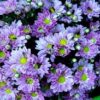**Chrysanthemums in Folk Culture: Symbolism and Traditions**

Chrysanthemums hold a special place in folk culture around the world, revered for their symbolism, beauty, and associations with various traditions and rituals. From ancient customs to modern celebrations, chrysanthemums have left an indelible mark on folklore, art, and cultural practices. This exploration delves into the rich tapestry of chrysanthemums in folk culture, uncovering their significance in different societies and highlighting the enduring legacy of these beloved flowers in the collective imagination.
**1. Symbolism of Chrysanthemums**
Chrysanthemums are imbued with deep symbolism that resonates across cultures and generations:
– **Longevity and Resilience**: In many Asian cultures, chrysanthemums symbolize longevity, resilience, and the enduring spirit of life. They are often associated with the virtues of perseverance and fortitude.
– **Remembrance and Honor**: In Western traditions, chrysanthemums are symbolic of remembrance and honor, particularly in the context of memorial services and cemetery decorations. White chrysanthemums, in particular, convey sincerity and respect.
– **Renewal and Transformation**: Chrysanthemums represent renewal and transformation in the language of flowers, signifying the beauty of change and growth.
**2. Chrysanthemums in Art and Literature**
Chrysanthemums have inspired artists, poets, and writers throughout history:
– **Japanese Ikebana**: Chrysanthemums are integral to the art of ikebana (Japanese flower arranging), where they symbolize perfection and beauty. Ikebana arrangements featuring chrysanthemums reflect harmony with nature and meticulous craftsmanship.
– **Literary References**: Chrysanthemums appear in poetry and literature across cultures, evoking themes of beauty, transience, and the passage of time. Writers use chrysanthemums as metaphors for human emotions and experiences.
**3. Festivals and Celebrations**
Chrysanthemum festivals are celebrated in various countries, showcasing the cultural significance of these flowers:
– **China**: The Chongyang Festival (Double Ninth Festival) in China features chrysanthemum displays and activities, honoring the elderly and celebrating longevity.
– **Japan**: The Festival of Happiness (Kiku no Sekku) in Japan is dedicated to chrysanthemums, showcasing elaborate floral arrangements and bonsai chrysanthemum displays.
– **Korea**: Chrysanthemum exhibitions are held during the Chrysanthemum Festival (Gukhwa Jeon) in South Korea, highlighting the beauty and diversity of chrysanthemum cultivars.
**4. Medicinal and Culinary Uses**
Chrysanthemums have medicinal and culinary applications in traditional folk practices:
– **Herbal Remedies**: Chrysanthemum tea is valued in traditional Chinese medicine for its cooling properties and benefits for eye health. It is believed to have detoxifying and anti-inflammatory effects.
– **Edible Flowers**: In some cultures, chrysanthemum petals are used in culinary preparations, such as salads, soups, and teas. The delicate flavor of chrysanthemums adds a unique touch to dishes.
**5. Superstitions and Beliefs**
Chrysanthemums are associated with various superstitions and beliefs:
– **Funerary Traditions**: In Europe, chrysanthemums are often used as funeral flowers and are considered symbols of mourning and grief.
– **Lucky Charms**: In Japan, chrysanthemums are believed to bring good luck and prosperity, especially during the New Year celebrations.
– **Warding Off Evil Spirits**: In some cultures, chrysanthemums are planted near homes to ward off negative energy and protect against evil spirits.
**6. Cultural Heritage and Preservation**
Efforts are underway to preserve and promote the cultural heritage of chrysanthemums:
– **Conservation Gardens**: Botanical gardens and heritage sites showcase rare and heirloom chrysanthemum varieties, preserving their genetic diversity and cultural significance.
– **Educational Programs**: Cultural institutions offer workshops and educational programs on chrysanthemum folklore, fostering appreciation and awareness of traditional practices.
In summary, chrysanthemums play a multifaceted role in folk culture, embodying a tapestry of meanings, traditions, and rituals. Whether as symbols of longevity, subjects of artistic expression, or ingredients in herbal remedies, chrysanthemums continue to captivate hearts and minds around the world. Embrace the cultural richness of chrysanthemums and discover the profound connections between nature, tradition, and human experience through these beloved flowers.
**Chrysanthemums in Folk Culture: Customs, Beliefs, and Rituals**
Chrysanthemums, cherished for their beauty and symbolic significance, have woven themselves into the fabric of folk culture across the globe. From ancient rituals to modern customs, these resilient flowers have captured the imagination of communities and become integral to traditions passed down through generations. In this exploration of chrysanthemums in folk culture, we delve deeper into the customs, beliefs, and rituals surrounding these beloved blooms, uncovering the timeless allure and enduring legacy they hold in the hearts of diverse cultures.
**1. Chrysanthemums in Ceremonial Practices**
Chrysanthemums feature prominently in ceremonial practices and rites of passage:
– **Weddings**: Chrysanthemums are used in wedding bouquets and floral arrangements, symbolizing fidelity, longevity, and joyous celebrations. In some cultures, they represent the purity and innocence of the bride.
– **Funerals and Memorials**: Chrysanthemums are prevalent in funeral wreaths and arrangements, serving as symbols of remembrance and honor. White chrysanthemums, in particular, convey sincere condolences and reverence.
– **Festivals and Holidays**: Chrysanthemum festivals coincide with seasonal celebrations, showcasing the cultural significance of these flowers and their role in communal gatherings.
**2. Symbolism and Folklore**
Chrysanthemums embody deep symbolism and folklore across different societies:
– **Asia**: In Japan, chrysanthemums symbolize the imperial family and are associated with the Emperor. They represent honor, dignity, and the spirit of endurance.
– **Europe**: Chrysanthemums are linked to mourning and remembrance in European folklore, often used in cemeteries and memorial services.
– **China**: Chrysanthemums symbolize longevity and good fortune in Chinese culture, featured in artwork, poetry, and traditional ceremonies.
**3. Healing and Protection**
Chrysanthemums are believed to possess healing properties and protective qualities:
– **Medicinal Uses**: Chrysanthemum tea is consumed for its therapeutic benefits, believed to soothe headaches, improve eyesight, and promote overall wellness in traditional herbal medicine.
– **Amulets and Charms**: In some cultures, chrysanthemums are worn as amulets or carried as talismans for protection against negative energies and illness.
**4. Cultural Expressions through Art and Craft**
Chrysanthemums inspire artistic expressions and craft traditions:
– **Painting and Calligraphy**: Chrysanthemums are popular motifs in Asian brush painting and calligraphy, representing beauty, resilience, and the changing seasons.
– **Textile Arts**: Chrysanthemum patterns adorn fabrics and textiles, reflecting cultural aesthetics and design sensibilities.
**5. Superstitions and Folk Beliefs**
Chrysanthemums are associated with various superstitions and folk beliefs:
– **Dream Interpretation**: Dreaming of chrysanthemums is said to bring good fortune and positive outcomes in some folk traditions.
– **Home Blessings**: Placing chrysanthemums in the home is believed to bring blessings and ward off evil spirits, ensuring domestic harmony and prosperity.
**6. Conservation and Heritage Preservation**
Efforts are underway to preserve and promote the cultural heritage of chrysanthemums:
– **Cultural Institutions**: Museums and botanical gardens showcase chrysanthemum varieties and host exhibitions on their cultural significance.
– **Community Engagement**: Cultural organizations collaborate with communities to document and preserve traditional practices involving chrysanthemums.
In summary, chrysanthemums embody the essence of cultural heritage and folklore, transcending geographical boundaries to weave narratives of symbolism, tradition, and human connection. Whether in ceremonial rituals, healing practices, or artistic expressions, chrysanthemums continue to inspire reverence and admiration across diverse cultures. Embrace the enduring allure of chrysanthemums in folk culture and discover the profound meanings they hold within the tapestry of human experience.

